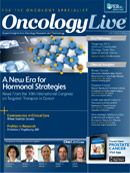Publication
Article
Oncology Live®
Small-Molecule Inhibitors Hold Promise for Elderly CLL Patients
Author(s):
In early clinical trials, small-molecule inhibitors have demonstrated improvement in response rates in elderly patients with chronic lymphocytic leukemia.
William G. Wierda, MD, PhD
In early clinical trials, small-molecule inhibitors have demonstrated improvement in response rates in elderly patients with chronic lymphocytic leukemia (CLL), suggesting that they may be an effective and viable treatment option for a population facing a high risk of shorter survival times and no established standard regimen of therapy.
“I think these agents will really change the face of how we manage CLL,” William G. Wierda, MD, PhD, said in an interview and presentation at the National Comprehensive Cancer Network 7th Annual Congress: Hematologic Malignancies, held in September in New York City. “I think maybe that these agents will eventually allow us to move away from chemotherapy and treat patients in a targeted fashion without having to use chemotherapies and the toxicities associated with chemotherapy.”
Wierda discussed three agents in particular during his presentation:
Ibrutinib
Ibrutinib (PCI-32765), the most developed of these emerging agents, is a Bruton’s tyrosine kinase (BTK) inhibitor. The mechanism of action allows it to promote apoptosis and inhibit cell migration and adhesion in CLL cells. It also is a targeted agent that has not shown any cytotoxic effects on T cells or natural killer (NK) cells. One side effect that has been observed is an initial rise in the lymphocyte count. Wierda said that is likely due to an immune response, so the criteria for its effectiveness has been adjusted so that lymphocyte count was not used as a means of assessing progression in these patients.
In a study presented at the 17th Congress of the European Hematology Association in June, the observed overall response rate for patients who had received a 420-mg daily dose of ibrutinib was 67% in patients who were relapsed or refractory at a median follow-up of 12.6 months, and 73% among treatmentnaïve patients at a median follow-up of 10.7 months.1 The median age for patients who were relapsed or refractory was 64 years, while the median age for treatment-naïve patients was 71 years.
The study found that 96% of patients who were at least 65 years old and received the 420-mg dosage experienced progression-free survival (PFS) of approximately 15 months. In the 420-mg cohort, 12% of patients achieved a complete response with no evidence of CLL.
In addition to the benefits observed thus far, Wierda said he is most excited about ibrutinib because of positive responses observed in a subset of patients with a chromosome 17p deletion, a highrisk population of patients that presents with shorter time to first therapy and poorer outcomes.
GS-1101
GS-1101, formerly known as CAL-101, is a potent PI3K delta inhibitor that targets a signaling pathway implicated in malignant B-cell proliferation. The drug has been explored as a monotherapy and in combination with other agents.
Wierda said that the monotherapy data that have been obtained thus far have been disappointing, but in combination with other agents, GS-1101 seems promising. When combined with rituximab, fludarabine, or bendamustine, the overall response rates ranged between 71% and 84%.
Wierda noted that a phase II study is currently under way for patients ≥65 years with previously untreated CLL who will receive GS-1101 in combination with rituximab versus placebo plus rituximab. The GS-1101 dosage being evaluated is 150 mg twice daily for 12 months (NCT01203930).
ABT-199
ABT-199 is a small-molecule inhibitor of bcl-2, a protein that is responsible for deregulation of apoptosis in cancer cells. One of the concerns over this drug is its propensity to result in tumor lysis syndrome, a complication of anticancer treatment in which metabolic byproducts are released into the bloodstream of the patient.
As such, a focus of studies into ABT-199 has involved dose escalation to determine the most appropriate and most tolerable dose for each patient. Activity has been observed in patients, including reduction in leukemia counts, reduction in lymph node size, and improvement in bone marrow. Like ibrutinib, ABT-199 has also shown activity in patients with the 17p deletion.
Although these drugs are being explored for adult patients of all ages, the need for new therapeutics is pressing for older people. “These patients don’t tolerate the standard chemo-immunotherapy treatments that we have developed, and they don’t tolerate the myelosuppression as well,” Wierda said. “So the whole CLL community is very excited about these small-molecule inhibitors and the continued development of these agents.”
Reference
1. O’Brien S, Furman R, Coutre S, et al. The Bruton’s tyrosine kinase inhibitor ibrutinib is highly active and tolerable in relapsed or refractory (R/R) and treatment naïve (TN) CLL patients, updated results of a phase IB/II study. Haematologica. 2012; 97(suppl 1:218; abstr 0542).










